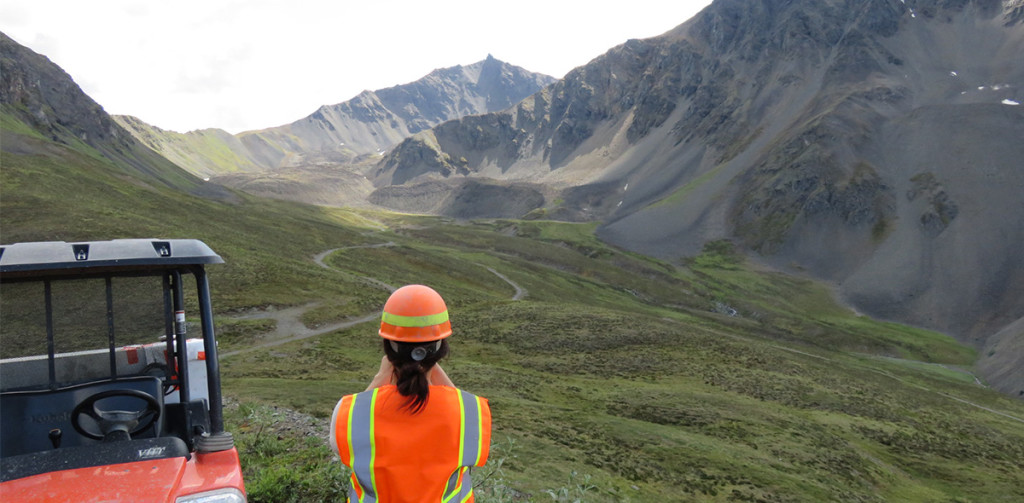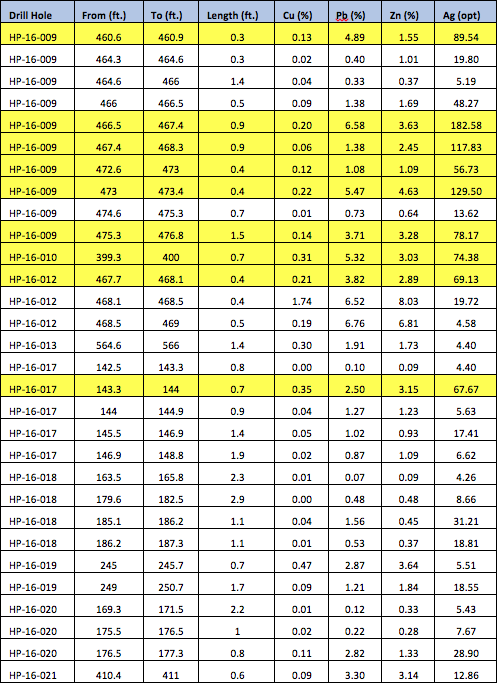
Historical exploration efforts at the Honolulu Prospect focused on defining silver and base-metal mineralization observed in float and outcrop within Discovery Creek. Grab sample assays indicated anomalous silver, extraordinarily high enough to warrant an initial drill program. Over five years in the late-70’s and early 80’s, eight short AX and BQ core holes were drilled by Dome Mines Ltd. and Pacific Cordilleran Exploration. Every hole drilled to the planned depth (two holes were lost short of the target) intercepted significant silver and base metal mineralization, including a 4’ interval in PCE-1 which assayed 124.5 ounces of silver per ton, 6.4% lead, and 4.5% zinc.
In 2016, the current 22 square mile block of Alaska State Claims was assembled and a 12-person work camp was established near Discovery Creek. During the summer, 16 drill holes of HQ and NQ core were completed totaling 8,645’ of drilling. The core was logged, photographed and 431 intervals were selected for cutting and assay using 48 multi-element analysis. A tight soil sample grid with 50’ centers along lines perpendicular to Discovery Creek spaced 500’ apart consisting of 1,505 samples was completed as well as three smaller grids over Cayos Creek, Bertram Gulch and Solitude Pass. A ground Magnetic and VLF geophysical survey was completed on the same lines as the soil sampling grid over Discovery Creek. An additional 124 grab samples were collected from across the claim block during prospecting and geologic mapping.
2016 Drilling intercepts with >4 opt Ag mineralization are shown below:

High-grade silver and base metal veins in the Discovery Creek prospect occur as a stockwork of anastomosing veins within a 200’ wide structural zone striking N30W dipping steeply to the east. The mineralized zone has a tested strike length of 1000’ and 600’ down dip, and remains open in all directions. The veins have a mineralogy consisting of galena, sphalerite and tetrahedrite followed by semi-massive pyrite and chalcopyrite with total sulfide content >50%. The veins are hosted in a quartz monzonite and seem to be intimately associated with the intrusion of quartz latite porphyry dikes that strike roughly NNW. Based on the magnetic and VLF geophysical surveys and soil sampling conducted in 2016, multiple parallel enechelon blind faults/structures exist to the NW and SE, greatly expanding the area of interest and opportunity. The 20,000 feet of drilling in 2017 will focus on expanding known mineralization in Discovery Creek as well as testing the blind parallel enechelon structures to the NW and SE.
Two miles to the southeast of the Discovery Creek prospect, the Tempest zone was identified to contain base-metal and silver-bearing veins in quartz monzonite occurring near the contact of NNW-striking E-dipping quartz latite porphyry dikes. A grab sample collected in 2016 from an oxidized sulfide vein in outcrop contains 8.26% Pb, 6.47% Zn and 203.0 opt Ag. Based on the mineralogy and geometry, there is a strong chance the Tempest zone maybe genetically and spatially related to the mineralization found in the Discovery Creek prospect.
From the Tempest zone to Bertram Gulch, almost one mile due east, disseminated arsenopyrite and drusy qtz repeatedly occurs in silicified zones in the footwalls of enechelon NW-striking and NE-dipping mafic dikes. A grab sample of the arsenopyrite-bearing material in Bertram Gulch ran 7.3 opt Ag and 0.03 opt Au. A grab sample of similar arsenopyrite-bearing material from the Tempest zone ran 3.88 opt Ag and 0.01 opt Au. The relationship between the base-metal silver veins found in Tempest and Discovery Creek and the lower-grade disseminated silver and gold in Tempest and Bertram Gulch is unknown but the spatial extent of precious-metal-bearing disseminated arsenopyrite is significant and warrants further investigation. Similarly, one mile to the east of the Discovery Creek prospect, silver and gold-bearing sheeted arsenopyrite veins hosted in quartz monzonite outcrop in an area named Tiki Chute. A grab sample collected from the massive arsenopyrite veins contains 0.05 opt Au and 2.67 opt Ag.
Furthermore, two areas in the northeastern portion of the claim block (Copper and Alligator Ridges) contain chalcopyrite and secondary Cu-oxides that occur within roughly east-striking south-dipping veins and fractures in quartz monzonite. These veins/fractures occur in an area with abundant gossens and broad sericitic alteration and may be indicative of a copper porphyry at depth. A grab sample from outcrop below Alligator Ridge with malachite on fractures contained 6.33 opt Ag and 5.8% Cu. These areas are currently under-explored but demand attention this upcoming summer.
